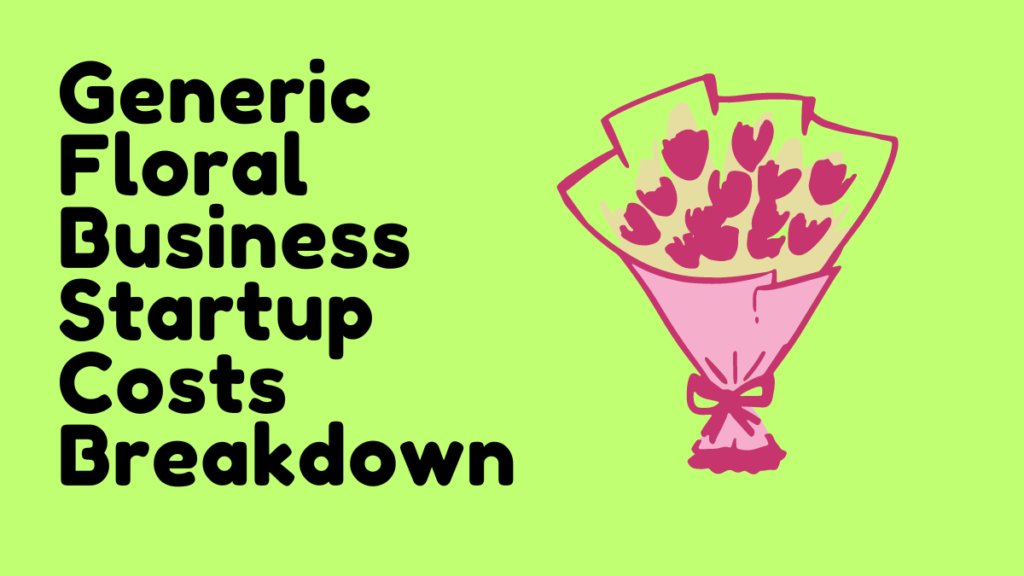Floral Businesses
Are Floral Businesses Profitable? Floral businesses, encompassing flower shops, nurseries, and online flower delivery services, play a crucial role in various aspects of life. Whether it’s expressing love, celebrating milestones, or conveying condolences, flowers hold a special place in human culture. This article delves into the profitability of floral businesses, examining historical trends, current market dynamics, and strategies to enhance profitability.
The Flower and Ornamental Plants global market is projected to experience a growth rate of 6.3% in the next five years, reaching a valuation of $57.4 billion USD by the year 2024. The market for flower and ornamental plants is anticipated to expand by $30.79 billion from 2022 to 2027, with a Compound Annual Growth Rate (CAGR) of 5.85% during this period.
The Profitability of Floral Businesses
Floral Fortunes Over Time: A Peek into the Past
Understanding the historical performance of the Floral industry provides us with valuable insights into how it has weathered changes and challenges over the years. By examining past trends, we gain a clearer perspective on what factors influenced demand and profitability. This historical journey acts as a guide, helping us anticipate and navigate future market conditions more effectively.

Blooms Today: Checking Out What’s Hot in the Flower Market
In the ever-changing landscape of the floral market, it’s crucial to stay updated on current trends. This involves exploring what consumers are leaning towards, the latest styles, and how external factors like weather or significant events impact the market. By delving into the present, we can better understand the dynamics that shape the floral industry today and make informed decisions.
Petal Profits: Finding the Money in Different Flower Deals
At the heart of any business lies the question of profitability. In this section, we dissect the financial side of floral businesses by looking at profit margins across various segments. By understanding the financial intricacies, we identify areas where improvements can be made. This helps create a roadmap for enhancing overall financial prosperity within the diverse realms of the floral industry. It’s essentially breaking down the dollars and cents to reveal the monetary potential within different aspects of the flower business.
Factors Influencing Profitability
Understanding the Seasons: How Changes in Weather Impact Flower Demand
Ever wondered why flowers seem more popular during certain times? Seasonal changes play a big role. We’ll take a closer look at how different seasons affect the demand for flowers and figure out smart ways to keep business blooming, no matter the weather.
Where You Bloom Matters: How Your Shop’s Location and Customers Influence Profits
Believe it or not, where your flower shop is located makes a big difference. We’ll explore why the location is so crucial and how the people around your shop, your target customers, can affect the overall success of your floral business. It’s like finding the perfect soil for your business to grow in.
Cracking the Code: Understanding and Beating Your Flower Shop Competitors
In the world of flowers, it’s not just about pretty blooms – it’s also about outshining your competitors. We’ll dive into the competitive landscape, find out who your main rivals are, and come up with clever strategies to stay ahead in the flower game.
The Quality Quotient: How Top-Notch Products and Services Boost Your Floral Business
Ever bought flowers and felt disappointed? It happens, and that’s why the quality of what you sell matters. We’ll explore how offering the best products and services not only attracts customers but keeps them coming back. Think of it as planting the seeds for long-term success in the floral world.
Generic Floral Business Startup Costs Breakdown

| Category | Amount Required ($) |
| Premises Requirement | |
| Lease/Rental Deposit | $10,000 |
| Interior Decoration | $5,000 |
| Utilities (first month) | $500 |
| Renovation and Setup | $7,000 |
| Security Deposit for Utilities | $1,000 |
| Capital | |
| Initial Inventory | $15,000 |
| Equipment (Coolers, Workstations) | $8,000 |
| Point of Sale System | $2,500 |
| Furniture and Decor | $3,000 |
| Computer and IT Infrastructure | $2,000 |
| Material | |
| Fresh Flowers | $5,000 |
| Packaging Materials | $1,500 |
| Vases and Arrangement Tools | $2,000 |
| Ribbons, Wraps, and Decorative Items | $1,000 |
| Staff | |
| Employee Salaries (first month) | $8,000 |
| Training Expenses | $2,500 |
| Uniforms and Workwear | $1,000 |
| Expenses | |
| Marketing and Advertising | $3,000 |
| Licenses and Permits | $1,500 |
| Insurance | $1,200 |
| Website Development and Maintenance | $2,000 |
| Miscellaneous Expenses | $2,000 |
| Technology | |
| POS Software and Hardware | $2,500 |
| Security Systems (CCTV, Alarms) | $1,500 |
| Training and Development | |
| Employee Training Programs | $3,000 |
| Professional Memberships | $500 |
| Contingency Fund (10% of Total) | $9,920 |
| Total Initial Investment | $87,120 |
| Profit (Estimated for the first year) | $30,000 – $50,000 |
“The example provided is a generic breakdown of the initial setup requirements for starting a floral business and does not specify a particular country. The costs outlined are hypothetical and can vary based on the location, market conditions, and specific business plans. If you have a specific country or region in mind, you may need to adjust the amounts and categories to align with the local economic factors and business environment”
Increasing business profit involves a combination of strategic planning, efficient operations, and effective marketing
- Cost Management:
- Expense Review: Regularly review your business expenses. Identify areas where costs can be reduced without compromising quality.
- Negotiate with Suppliers: Negotiate better deals with suppliers or explore alternative suppliers for cost savings.
- Revenue Enhancement:
- Diversify Product/Service Offerings: Expand your product or service offerings to attract a broader customer base.
- Pricing Strategies: Consider adjusting your pricing strategy. This could involve a moderate price increase for certain products or services.
- Customer Retention:
- Customer Loyalty Programs: Implement loyalty programs to encourage repeat business and reward loyal customers.
- Quality Customer Service: Provide excellent customer service to enhance customer satisfaction and loyalty.
- Marketing and Sales:
- Targeted Marketing: Focus on targeted marketing efforts to reach the right audience and improve conversion rates.
- Online Presence: Strengthen your online presence through effective digital marketing strategies.
- Operational Efficiency:
- Streamline Processes: Identify and eliminate inefficiencies in your operations to reduce costs and improve productivity.
- Employee Training: Invest in training to enhance employee skills and efficiency.
- Technology Integration:
- Automation: Integrate automation where possible to streamline repetitive tasks and reduce operational costs.
- Data Analytics: Use data analytics to gain insights into customer behavior and market trends for informed decision-making.
- Cost-Effective Marketing:
- Social Media Marketing: Leverage cost-effective social media marketing to reach a wider audience.
- Referral Programs: Implement referral programs to encourage existing customers to bring in new business.
- Partnerships and Collaborations:
- Collaborate with Complementary Businesses: Partner with businesses that complement yours for mutual promotion and increased customer reach.
- Continuous Improvement:
- Feedback and Adaptation: Seek customer feedback and adapt your products/services based on changing market trends and customer preferences.
- Regular Assessments: Conduct regular assessments of your business strategies and adjust them based on performance.
- Financial Management:
- Working Capital Management: Manage your working capital effectively to ensure sufficient cash flow for day-to-day operations.
- Invest Wisely: Consider smart investments that have the potential to generate additional revenue.
Remember, the key is to implement these strategies systematically, monitor their impact, and adapt as needed. It’s often a combination of small improvements across various aspects of your business that leads to significant overall profit growth.
Strategies for Enhancing Profitability

Boosting Your Flower Shop’s Profits: Clever Ways to Make More Money
Mixing It Up: Why Offering a Variety of Products Is a Game-Changer
When it comes to flowers, variety is the spice of life. We’ll explore why having a mix of different flower arrangements and products can keep customers happy and coming back for more. It’s like creating a garden of choices for everyone to enjoy.
Going Digital: Why Being Online Can Blossom Your Business
Blooming Online: How the Internet Can Supercharge Your Flower Shop
In a world that’s always connected, having an online presence is crucial. We’ll talk about why being on the internet and selling flowers online can open up a whole new world of customers. Think of it as putting your flower shop on a global stage.
From Garden to Customer: Making Your Supply Chain Smarter
Flower Power Logistics: How a Smart Supply Chain Boosts Your Bottom Line
Behind every beautiful bouquet, there’s a supply chain at work. We’ll dig into how streamlining this process can save you money, cut down on waste, and ensure that your flowers are always fresh and top-notch. It’s like tending to your garden in the most efficient way possible.
Spreading the Floral Love: How Marketing and Branding Grow Your Business
Blooms That Sell: Crafting a Brand and Marketing Strategy That Works
Having the best flowers isn’t enough if people don’t know about them. We’ll discuss the importance of creating a strong brand identity and effective marketing strategies to make your flower shop stand out. Think of it as putting up a big sign that says, “Come get the best flowers in town!”
Legal Considerations in Floral Businesses
Essential Paperwork: The Lowdown on Licenses and Permits
Running a flower shop means dealing with more than just flowers – there’s paperwork too. Let’s break down the legal stuff, like licenses and permits. Think of it as your floral business roadmap to stay on the right side of the law.
Growing Legally: Why Following Agriculture Rules Matters for Your Flowers
Floral Legality 101: Staying on the Right Side of Agricultural Rules
Each petal you sell needs to follow the rules. We’ll dig into why sticking to agricultural regulations is crucial. It ensures your flowers are not only legal but also top-notch quality. It’s like giving your business a solid legal foundation to thrive.
Blossoming Brands: How to Protect Your Unique Flower Creations
Flower Power Ownership: Safeguarding Your Ideas and Brand
Your flower arrangements and business brand are like your unique signature. Let’s chat about how to make sure they’re protected. We’ll discuss securing your intellectual property rights, ensuring what makes your business special stays yours. Picture it as putting a fence around your creative garden.
Floral Fairness: Creating a Safe and Happy Workplace
Blooms and Rights: Building a Fair and Safe Workplace for Your Team
Your flower success is tied to the people who work with you. Let’s dive into the importance of following labor laws and creating a workplace where everyone feels safe and valued. It’s like tending to a garden of teamwork and respect in your business.
Trends in the Floral Industry

Eco-Friendly Blooms: Why Sustainability Matters in the Floral World
Let’s talk about being green in the floral industry. We’ll explore why sustainable practices, like eco-friendly growing methods, are becoming a big deal. It’s like planting seeds for a better, greener future in the flower business.
Tech in Bloom: How Gadgets and Gizmos Are Changing Flower Shops
Flower Power Tech: The Cool Ways Technology is Shaping Flower Businesses
Technology isn’t just for gadgets; it’s transforming flower shops too. We’ll dive into how online ordering systems and fancy logistics solutions are reshaping the floral business landscape. Imagine it as giving your flower shop a tech-savvy makeover.
Petals in Demand: How What People Like Is Changing in the Flower World
Blooms on Demand: What People Want in Flowers Is Changing
Let’s chat about what people are into when it comes to flowers. From the types of flowers to how they’re arranged and even how they get delivered – we’ll explore the changing preferences in the floral world. Think of it as keeping up with the ever-evolving flower fashion.
Analyzing Profitability Through Trends Graphs
Understanding Profitability through Trends
Graphs that Speak: Making Sense of Market Trends through Visuals
Ever feel lost in a sea of numbers? We’ll use graphs as our treasure maps to showcase historical and current market trends. It’s like having a visual guide to navigate through the complexities of financial data, making it crystal clear for everyone.
Time Travel with Numbers: Comparing Profits Through the Ages
Money Talks Through Time: Comparing Profits to Spot Patterns
Let’s time-travel with numbers! We’ll compare how profitable your flower business has been over different time periods. It’s like putting on detective glasses to spot patterns and draw smart conclusions about your business’s financial journey.
Human-Friendly Approaches in Floral Businesses
Cultivating Connections in Floral Businesses: Prioritizing Human Relations
Client Harmony: Nurturing Strong Customer Relationships for Loyalty and Repeat Business
In the realm of floral businesses, building and sustaining meaningful connections with customers are paramount. We’ll delve into the strategic significance of fostering customer relationships, emphasizing their role in cultivating loyalty and encouraging repeat business. It’s like planting the seeds for a flourishing customer base.
The Review Mirror: Unveiling the Significance of Customer Feedback
Feedback Elegance: Harnessing Customer Reviews to Boost Reputation and Trust
In the digital age, customer reviews are the currency of reputation. We’ll explore the art of leveraging positive reviews and tactfully addressing negative feedback to enhance the standing of your floral business. It’s akin to using customer feedback as a mirror to reflect and refine your business practices.
| Pros | Cons |
|---|---|
| 1. Creative Expression: | 1. Seasonal Demand: Fluctuations in |
| Engage in artistic expression | demand based on seasons can impact |
| through floral arrangements. | sales. |
| 2. Broad Market: | 2. Perishable Inventory: Flowers are |
| Target various occasions and | perishable, leading to potential |
| markets, including weddings, | losses from unsold inventory. |
| events, and everyday customers. | |
| 3. Emotional Connection: | 3. Intensive Competition: Saturation |
| Flowers evoke emotions, making | in the floral market may require |
| it a meaningful gift choice. | differentiation strategies. |
| 4. Repeat Business: | 4. Fragile Supply Chain: Dependence |
| Occasions like birthdays and | on suppliers and transportation |
| anniversaries create repeat | logistics can be challenging. |
| business opportunities. | |
| 5. Low Barrier to Entry: | 5. Seasonal Variability in Prices: |
| Entry costs can be relatively | Fluctuations in flower prices based |
| low, allowing for small-scale | on seasons and market conditions. |
| entrepreneurs to start. | |
| 6. Eco-Friendly Trends: | 6. Perishable Nature of Products: |
| Growing demand for sustainable | Limited shelf life can lead to waste |
| and eco-friendly options. | and disposal challenges. |
| 7. Networking Opportunities: | 7. Highly Dependent on Trends: |
| Collaboration with event | Staying updated on floral trends is |
| planners, venues, and other | crucial for sustained popularity. |
| businesses for mutual benefits. |
It’s important to note that the success of a floral business depends on factors such as location, marketing strategies, and the ability to adapt to market trends.
Blooms and Beyond: Nurturing Employee Excellence for Business Harmony
Workforce Flourish: Acknowledging the Impact of Employee Training and Satisfaction
Behind every successful floral business is a team of well-trained and content employees. We’ll recognize the pivotal role of employee training and satisfaction in delivering exceptional customer service and ensuring the seamless operation of your business. Think of it as tending to the roots for a garden of professional excellence.
Case Studies
Success Stories of Profitable Floral Businesses: Examining case studies of successful floral businesses and extracting key strategies that contributed to their profitability.
Learning from Failures in the Industry: Analyzing instances of failed floral businesses to identify pitfalls and lessons that can be valuable for aspiring entrepreneurs.
20 Frequently Asked Questions (FAQs) Regarding the Profitability of Floral Businesses

| # | Question | Answer |
| 1 | Is starting a floral business a profitable venture? | Yes, floral businesses can be profitable depending on various factors such as location, market demand, and business management. |
| 2 | What factors influence the profitability of a flower shop? | Location, quality of products, pricing strategy, marketing efforts, and customer service are significant factors that impact the profitability of a floral business. |
| 3 | Are there peak seasons for floral sales? | Yes, holidays like Valentine’s Day, Mother’s Day, and weddings often result in increased demand for flowers, contributing to higher sales and potential profitability. |
| 4 | How important is a good location for a floral business? | Location is crucial; being situated in a high-traffic area or close to events like weddings and parties can significantly boost sales and overall profitability. |
| 5 | What types of flowers are most profitable to sell? | Popular and seasonal flowers, as well as unique and exotic varieties, can be profitable. Offering a diverse selection that caters to customer preferences is key. |
| 6 | How can I attract customers to my floral business? | Effective marketing strategies, social media presence, and collaborations with local businesses or event planners can help attract customers and increase profitability. |
| 7 | Are online sales important for floral businesses? | Yes, having an online presence is essential in today’s market. Online sales, through a website or platforms like social media, can significantly expand the customer base and revenue. |
| 8 | What are common challenges for floral businesses? | Challenges may include seasonal fluctuations, perishable inventory management, competition, and staying updated with floral design trends. |
| 9 | How can I control costs in a floral business? | Efficient inventory management, negotiating with suppliers, and optimizing operational processes can help control costs and improve overall profitability. |
| 10 | Is it necessary to have floral design skills to succeed? | While floral design skills are beneficial, hiring skilled florists or attending workshops can compensate. Excellent customer service and business management are equally crucial. |
| 11 | Are there any grants or funding options for floral startups? | Investigate local business grants, small business loans, and entrepreneurship programs that may offer financial support for starting or expanding a floral business. |
| 12 | What role do events and weddings play in floral business profitability? | Events and weddings can be lucrative, as they often involve bulk flower orders. Establishing partnerships with event planners and venues can enhance business opportunities. |
| 13 | How can I differentiate my floral business from competitors? | Unique floral arrangements, personalized services, and creative marketing campaigns can set your business apart and attract customers, contributing to profitability. |
| 14 | What is the average profit margin for a floral business? | Profit margins can vary, but a well-managed floral business typically aims for a profit margin of 10% to 20%, considering factors like overhead costs and pricing strategies. |
| 15 | How can technology be leveraged to enhance profitability? | Implementing online ordering systems, digital marketing, and using technology for inventory management and customer relationship management can improve efficiency and profitability. |
| 16 | What are the ongoing expenses of running a floral business? | Ongoing expenses include rent, utilities, floral supplies, staff wages, marketing costs, and insurance. Monitoring and managing these expenses are crucial for sustained profitability. |
| 17 | How important is customer loyalty in a floral business? | Customer loyalty is vital. Building strong relationships with customers through excellent service, loyalty programs, and personalized experiences can lead to repeat business and profitability. |
| 18 | Are there any trends in the floral industry affecting profitability? | Stay updated on trends such as sustainable practices, eco-friendly packaging, and digital marketing trends, as aligning with these can positively impact customer perception and profitability. |
| 19 | Can a small floral business be profitable in a competitive market? | Yes, by focusing on a niche, offering unique products or services, and providing exceptional customer service, a small floral business can carve out a profitable market share. |
| 20 | How long does it take for a floral business to become profitable? | The timeline varies, but with effective planning, marketing, and management, some floral businesses can start turning a profit within the first year, while others may take longer. |
Conclusion
In summary, success in the floral business demands financial savvy, market awareness, and customer-focused strategies. Profitability hinges on seasonal changes, competition, and consumer trends. Sustainable practices, technology, and quality ensure competitiveness. Efficient supply chains, marketing, and diversified products drive profitability. Strong customer relations, employee satisfaction, and legal compliance are vital. Online presence fuels growth, culminating in sustained profitability and customer delight.
Disclaimer:
The information provided is for general informational purposes only and should not be considered as professional advice. We recommend seeking specialized advice for specific situations.
